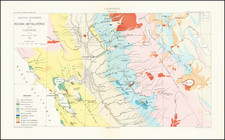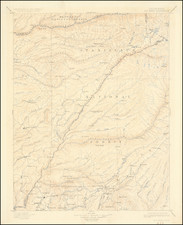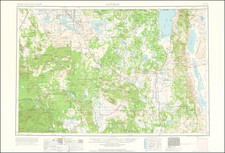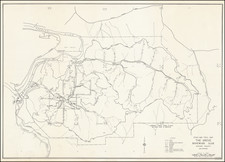Gold Rush Artist Writes to Fellow Artist in 1848
Slumming it in New Hampsire Before Heading to California
An interesting manuscript letter from noted artist of the California Gold Rush, William McIlvaine Jr. (1813-1867), to fellow artist Russell Smith (1812-1896). The letter comments on the local region surrounding Hanover, New Hampshire, suggests a trip to Franconia Notch in the White Mountains, refers to the upcoming "autumnal tints" in New Hampshire, mentions Russell Smith's wide-brimmed leghorn straw hat, and other personal matters.
The impecunious McIlvaine writes about a planned sketching trip with Russell, to Franconia Notch in the “very beautiful” White Mountains of New Hampshire - provided that Smith could provide “a statement of moderate expense” apparently subject to approval by McIlvaine’s uncle, a prominent Philadelphia physician.
After graduating from the University of Pennsylvania and studying art in Europe, McIlvaine mainly exhibited paintings of European landscapes. He became friends with Scottish-born Russell Smith, who was already well-established as a painter of panoramic landscapes and theatrical scenes. They presumably did travel together, as planned in the letter, as there are paintings and sketches by both men dated from that fall - when the world was thrilled by the announcement of gold discovered in California. Eight months after writing this letter, in 1849, McIlvaine sailed "around the horn" to San Francisco. Arriving on June 1, he went directly to the gold fields, where, as historian Robert Cleland later remarked, he “devoted more time to his sketch book than to the 'pick, pan, or shovel'".
After five months in California, McIlvaine began the trip home, traveling overland across Mexico, then sailing back to Philadelphia, where, in early 1850, he published Sketches of Scenery And Notes of Personal Adventure in California and Mexico, a book of 44 pages, notably illustrated with 16 full-page lithographic plates based on his original drawings. Gary Kurutz writes in his Gold Rush bibliography that McIlvaine's "album-like volume represents one of the earliest publications illustrated with 'on the spot' drawings."
California Panoramist
McIlvaine recruited Russell Smith to paint a “grand-scale panorama” based on his sketches, which was displayed in Philadelphia and Baltimore – one of several California panoramas on public view, but possibly the first based on the work of an artist who, as a Forty-Niner, had seen the gold country firsthand. While Smith continued to gain artistic renown for watercolors he painted at his Pennsylvania country studio, the work of McIlvaine, who made watercolors throughout the Civil War, was all but forgotten until his rare Gold Rush sketch book was posthumously reproduced in 1951 by the Grabhorn Press as one of only a dozen Gold Rush "narratives of personal experience” published “while the Gold Rush was still in progress."
McIlvaine may be considered the first published American artist of the California Gold Rush, and this letter to Smith, who brought his work to the attention of the Eastern public, stands as a nice historical association.
The text of the letter here follows:
Hanover August 28, 1848
My Dear Friend,
Yours of 9: Just came duly to hand. It unfortunately arrived an hour or two after the Dr. had left for Boston = and before he returned from there I had started on my little trip down the river = but on my return my landlady told me the Dr. had called at the museum but could not see you (it must have been the Saturday you left) and before I got back from my trip down the river = he had started on one up the [the?] river = I have been putting off answering your letter thinking he would return soon = but as September is approaching = could not put if off any longer = though he will certainly be back in a few days when I will lay your letter before him.
I would now like to remain here till the 16th or 18th of Sep: as it is a cheap place = & I should like to see the autumnal tints before returning = but as I have not been doing a great deal of business here = would hardly like to join you on your trip unless you could give me a statement of moderate expense = there is one thing I could promise for certain = that is = if you could come through this place on your way (which for other reasons I think would be your best) I would join you to go to the Franconia Notch [White Mountains] which we missed = it is only about 55 miles from here = and a regular cheap stage route = first to Haverill, 35 miles north = & said to be very beautiful & from there across the switch = I can't say much for the scenery around here = it is nothing at all compared with that north of Conway = you would never think there was a river within 50 miles = it is so hid by high sand banks = but nevertheless you can't move in this part of the world without finding something that's pretty = I have got some fine sketches since being here = I start off tomorrow to make a visit of a few days into Vermont = to see some friends I have made = about 30 miles from here.
Please write me on receipt of this if it would suit your arrangements to pass through here about the 16 or 18th = and if it does you can fix your day & depend upon me for the Franconia Notch = & perhaps more if the expense is not too great = say also if you propose bringing regular baggage, or only walking quantity = as I will join you either way = in the latter case will send my trunk by Express to Boston to wait for me.
You can get here by way of New Haven & up the Connecticut = in which case you will find a railroad to Greenfield = or up the Hudson through Troy & the Champlain canal & Lake to Orwell opposite Ticonderoga = and from there a short stage ride across the green mountains to Bethel again on a soil road = which carries you to Lebanon on the Connecticut 4 miles below this place.
You will find me if you come at Mr. James Austin Smiths, 1st house north of the Medical College = don't forget the medical, for the first house north of the college proper is inhabited by a namesake of young Mr. Russell Smith = to whose house nearly all the things I have ordered from Boston go in mistake = so look out that you don't go too = How's the Leghorns? I advise you to get Mrs. Smith to mend it up so you can bring it along = the brims will be a capital thing to keep the September snows off = I don't know that I'll do without one = Please remember me to your family = I hope they all continue well = and believe me, yours sincerely, Wm. McIlvaine, Jr.
William McIlvaine Jr. (1813-1867)
William McIlvaine, primarily a watercolorist, received a master of arts degree from the University of Pennsylvania in 1832 and then traveled and studied in Europe for the next five years. Upon his return, he spent a number of years in his father’s business in Philadelphia before taking up art professionally about 1845.
McIlvaine traveled to the California gold fields and Mexico, gathering ideas for his paintings. In 1850 he published Sketches of Scenery and Notes of Personal Adventures in California and Mexico containing sixteen plates after his own views of the mines.
A panorama based on his sketches was painted by Russell Smith and shown in Philadelphia in 1850 and Baltimore in 1851.











![Chart of the Coast of California from San Blas to San Francisco Drawn chiefly from the Spanish Surveys, the Charts of Vancouver &c. the whole much improved by recent observations made by English and French Naval Officers . . . 1854 [Additions to 1862]](https://storage.googleapis.com/raremaps/img/small/58999.jpg)

![[ Baja California / Mexico ] Carta particolare della parte ocidentale della nuova Spagnia, e del la California . . . D'America Carta XXXI](https://storage.googleapis.com/raremaps/img/small/101394.jpg)


